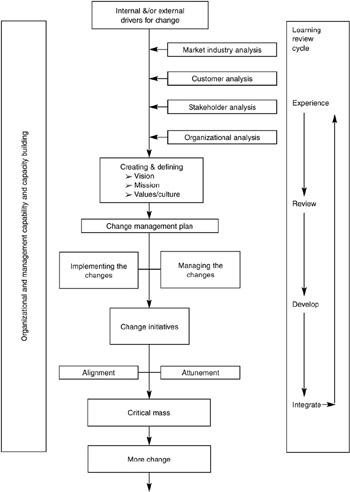Part II - The Applications
II The Applications
INTRODUCTION: STRATEGIC CHANGE OPTIONS
Strategy is the pattern or plan that integrates an organization’s major goals, policies and action sequences into a cohesive whole.
James Quinn (1980)
In Part One we looked at change and the management of change from three different perspectives: the individual, the team and the organization. We also examined the roles, styles and skills needed to become a successful leader of change.
In Part Two we apply this learning to specific types of change. We have identified four generic change scenarios, and we look at the particular management challenges involved in initiating and implementing each type of change. These change scenarios are:
- structural change;
- mergers and acquisitions;
- cultural change;
- IT-based process change.
We look at what differentiates these changes, and for each scenario we identify which approach to managing organizational change is the most relevant, and look at the implications for individuals and teams. We also give tips and resources for managers in these situations.
In this introduction we briefly review the strategic change process, identifying the elements that make a strategic change process successful.
STRATEGIC CHANGE PROCESS
When we look at Figure II.1 we can see that typically the whole process begins with an internal or external trigger for change. In a way we compartmentalize the universe in order to make sense of it. This whole book is an attempt to make order out of the chaos we sometimes feel around change. It is very rare that anyone could say for sure that this change began on that particular day or at that particular meeting. But in our ideal universe these triggers for change make us take a long hard look at the market or industry we are in, examine our customer and stakeholder relationships, and scrutinize our organizational capability. And as a result we review where we want to be, how we want to get there and what we need to do to get there. We develop our new vision, mission and values.

Figure II.1: The strategic change process
Now all sorts of changes may need to happen as a result of this exercise, but typically we will need to adjust one or all of the following:
- the organizational structure;
- the commercial approach;
- the organizational culture;
- the relevant processes.
OVERVIEW OF STRUCTURE
We tackle all four types of change identified above. In Chapter 5 we tackle structural changes head on. This is because we observe how many strategic changes result in structural changes, and we wanted to write something helpful about how to make this approach work well. Chapter 6 tackles mergers and acquisitions, and deals with change situations when competitors or suppliers (and indeed customers) are brought into the organization. Although it is not specifically addressed, many of the issues raised are pertinent to partnering as well. Chapter 7 focuses on cultural change, and specifically deals with three areas: aligning the organization to a market and customer focus, aligning the organization to its overarching objectives, and developing an employee brand. All three areas have something important to say about how to tackle cultural change. Finally Chapter 8 is focused on IT-enabled process change, as so many of us have undergone change as a direct result of developments in technology or the re-engineering of processes.
Other important aspects of the change process
There are five other essential characteristics of successful strategic change initiatives:
- Alignment is an important feature of a successful change initiative. This is about ensuring that all the components of the change plan are an integrated whole. This means that they have an internal integrity but are also linked into the whole organizational system and beyond, if necessary.
- Attunement is important too. This is about mirroring the preferred organizational culture, and ensuring that all aspects of the change are carried out in line with organizational values and with sufficient attention to the human side of change.
- Critical mass is vital. The aim of a change management plan is to develop momentum and build sustainability. This occurs when a sufficiently critical mass of people are aligned and in tune with senior management.
- Building organizational capability. Change management capacity and capability within organizations vary dramatically. Even organizations that seem to go through constant change do not necessarily have this as a key competency within their people. Our contention is that the more the senior management recognizes the need to develop this capability within itself and a significant proportion of its managers, the sooner change can become a way of life and not something to be feared, shunned and avoided.
- Encouraging individual learning. Change managers should be well supported with training and coaching if they are to be successful. Some succeed without this, but they are the exception. Usually the demands of implementing change, together with a need to keep the day-to-day requirements of the job going, mean that everything gets done in a rush, without pausing to review, develop or integrate. The habit is then set: managers hop from experience to experience without learning very much.
As you go through the following chapters, it may help to refer back to Figure II.1 as you think through how each type of change can be achieved successfully as part of an organization-wide strategic change.
Part I - The Underpinning Theory
Part II - The Applications
EAN: 2147483647
Pages: 96
